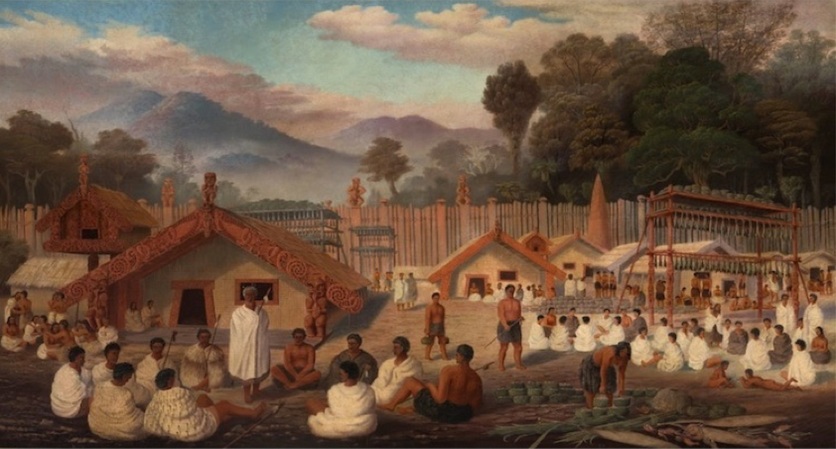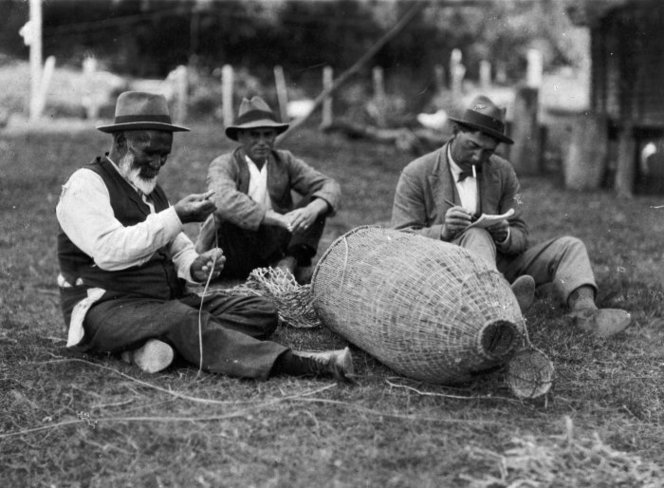Mātauranga Māori is a modern term for the combined knowledge of Polynesian ancestors and the experiences of Māori living in the environment of Aotearoa. The term takes many forms, such as language (te reo), education (mātauranga), traditional environmental knowledge (taonga tuku iho, mātauranga o te taiao), traditional knowledge of cultural practice, such as healing and medicines (rongoā), fishing (hī ika) and cultivation (mahinga kai).
In a traditional sense, mātauranga Māori refers to the knowledge, comprehension or understanding of everything visible or invisible that exists within the universe.
How did mātauranga Māori develop?
Early Māori culture was based on oral lore and had a justice system based on chiefs and tohunga (the knowledge experts). Such experts were chosen from an early age and educated within wānanga (learning institutions) to remember vast amounts of knowledge. The knowledge of the hapū (tribe) and iwi were entrusted to these experts, who would then pass their knowledge on to future experts. The way to memorise such a volume of complex material involved using a whakapapa (genealogical) framework. Whakapapa is used to explain genealogies and taxonomies, to create categories and families of flora and fauna and to describe environmental and life issues. The example below describes the whakapapa of different stones and their grouping:
From chaos sprang Papatūānuku, the Earth mother. Then Papa-matua-te-kore, the parentless, appeared. She mated with Rangi-a-Tamaku. Their firstborn was Putoto, whose sister was Parawhenuamea, the personified form of water. Putoto took his sister, Parawhenuamea, to wife. She gave birth to Rakahore, who mated with Hinekuku, the clay maiden. Hinekuku gave birth to Tuamatua. Tuamatua was the guardian of the different stones and gravel found on sea coasts. The younger brother of Tuamatua, Whatuaho, typified greywacke and chert. Next came Papakura, the origin of volcanic stone…
Retaining understanding in this way has enabled Māori knowledge to be passed on from one generation to another. This body of knowledge arises from the experiences of Māori living in the environment of Aotearoa. Many people have realised that mātauranga Māori contains useful knowledge, for example, about utilising and preserving the environment.
Māori knowledge and uses for fungi is a field that scientists have been looking into. For her master’s degree, ethnobotanist Dr Rebekah Fuller researched ancestral knowledge of fungi including uses of āwheto, the vegetable caterpillar fungus.
Mātauranga Māori and science?
There has been debate as to whether mātauranga Maori can be referred to as Māori science. Some suggest that mātauranga Māori is not science. Science and mātauranga Māori do not seek to do the same thing. Mātauranga Maori is knowledge – knowing about things (such as preparing poisonous karaka berries for eating). Science is about finding out why and how things happen (such as why and how karaka berries are poisonous and how preparation removes the poison).
Mātauranga Māori is a knowledge base in its own right. It is Māori knowledge, including values and culture. It is different from modern science. Mātauranga Māori belongs to iwi and should remain under Māori control. Mātauranga Maori is taonga (a treasure) and as such should be protected.
Nature of science
Scientists are recognising the value of Māori knowledge, particularly that concerned with the natural world and ecology. Collaboration with hapū and iwi is becoming an important part of environmental science as we all endeavour to make our environment sustainable.
He reo nō te puehu – A voice from the dust (and its accompanying activity) illustrate how the connections/overlap between mātauranga Māori and conventional science enhance our understanding of lake ecosystems.
Māori knowledge of animals provides brief explanations of six animal groupings based on the importance of the animals to tūpuna, and whakapapa and ancestry. The article notes the overlaps between mātauranga Māori and science and science but notes there are interesting differences between the two.
Vision Mātauranga
Vision Mātauranga is a government policy that aims to unlock the science and innovation potential of Māori knowledge, resources and people for the environmental, economic, social and cultural benefit of New Zealand. Vision Mātauranga forms a core part of each of the 11 National Science Challenges. Individual scientists are also working more closely with Māori communities, incorporating mātauranga Māori within their scientific research.
Māori communities also benefit when scientists forge strong relationships with local communities and iwi. This enables science research to develop from the experiences or needs of the people. When science knowledge is shared with iwi, it can be beneficial, for example, concerning kaitiakitanga (guardianship of the land). Māori as tangata whenua of Aotearoa, iwi and hapū have an inherent responsibility as kaitiaki (those who carry out kaitiakitanga). Science knowledge can contribute to that task. Mātauranga Māori and science can complement one another, benefiting both Māori (as kaitiaki) and scientists (in their research).
Project Mātauranga
Project Mātauranga is a television series that investigates Māori world views and methodologies within the scientific community. The Science Learning Hub has been fortunate to be able to present some of their episodes with related articles:
- Preserving harakeke taonga
- Taewa and psyllid resistance
- Reviving toheroa
- Kaitiaki of the Kiwi
- Revitalising Māori astronomy
- Restoration of a wooden pare
- Sea sponges and rongoā
- Insects and forest ecosystems
- Restoring mauri after the Rena disaster
Connected articles
Discover more about the research of Dr Pauline Harris in Listening to the land. She is working with a team of researchers to collect and record mātauranga from iwi and hapū about plants and animals in Aotearoa.
Counting kākahi tells the story of a scientist investigating black mussels in our lakes and rivers. It demonstrates how science increasingly draws on the knowledge of local iwi.
High school student Chris Ryan researched the medicinal properties of kawakawa, read about it in the The science of rongoā.
In Whakaotirangi and her kete of kūmara, learn how Tainui ancestor Whakaotirangi first brought kūmara and other plants to Aotearoa and the techniques she used to plant, grow and store them.
Te tapa ingoa – explore how early Māori went about naming and grouping the plants and animals they found around them.
Additional links
There are many different views on 'what is mātauranga Māori' and how it relates to western understandings of science. It is important to acknowledge the differing and evolving ideas within this area. In Mātauranga Māori—the ūkaipō of knowledge in New Zealand, scientist and established world expert on integrating indigenous knowledge and science, Dr Dan Hikoura, writes, "mātauranga Māori includes knowledge generated using techniques consistent with the scientific method, but explained according to a Māori world view".
In this 2007 report for Te Papa's National Services-Te Paerangi, Mātauranga Māori and Museum Practice: A discussion, Dr Charles Te Ahukaramū Royal includes a substantial exploration of 'what is mātauranga Māori'.
In the blog What is Mātauranga Māori?, science communicator Laura Goodall writes, "Mātauranga Māori can’t be translated or defined in a simple, two-dimensional way: it is multifaceted. There are many aspects to it". The blog also includes a video by Professor Steve Pointing and Dr John Perrott on "recognising Māori indigenous knowledge and values in research, education and kaitiakitanga".
To explore different aspects of mātauranga Māori and research utilizing science and mātauranga Māori have a look at our pinterest curation of resources here.
The article, Papatuanuku, Earth Mother: indigenous knowledge in 21st’century soil management, written by Robert McGowan, explores the concept of ‘mauri’ and how it relates to the capacity of soils to support the life that belongs there.
See the 2021 report He huringa āhuarangi, he huringa ao: a changing climate, a changing world from Ngā Pae o te Māramatanga and Manaaki Whenua providing guidance for Te Ao Māori on climate change adaptation and mitigation.
Read this article by Dr Georgina Stewart, her aim is to unpack the issues implicit in the current trends to incorporate Māori knowledge in the secondary science curriculum and help science teachers see the new standards in a more balanced and optimistic way.
Stewart, G. (2022). Mātauranga Māori and secondary science teaching: 2022. Teachers’ Work, 19(2), 84-90. https://doi.org/10.24135/teacherswork.v19i2.359.
Watch this Mātauranga Māori in Education, Education Hub webinar recording with Dr Te Ahukaramū Charles Royal (Marutūahu, Ngāti Raukawa, Ngā Puhi) from 2023.
Related content
Indigenous knowledge is increasingly valued, but to fully respect it we need to decolonise science – find out more in this article.
Webinars
Discover more in these recorded PLD webinars:
- Matauranga Māori
- Opportunities for using te reo Māori
- Mātauranga and the Living World
- Whakanui pūtaiao
- Te Repo – wetlands as a context for learning
- Tame Malcolm – indigenous pest management
- Local curriculum, mātauranga and science
- Te Kāhui o Matariki and the environment
Evolutionary biology
These articles look at the work of some of our evolutionary biologists and how their research in ancient DNA, palaeontology, archaeology and matāuranga Māori can be used to address a wide range of questions:
- Can customary harvesting of NZ’s native species be sustainable?
- How did ancient moa survive the ice age – and what can they teach us about modern climate change?
- Dead as the moa – oral traditions show that early Māori recognised extinction
Quiz
In the Māori knowledge and uses of fungi quiz, students can test their knowledge online or in a paper-based quiz. The quiz can be used as an introductory tool, a summative assessment or as an engaging treasure hunt to introduce students to some of the different fungi early Māori used for kai or rongoā.
Collection of related content
The Science Learning Hub team has curated a collection of resources related to opportunities for using te reo Māori. Login to make this collection part of your private collection, just click on the copy icon. You can then add additional content, notes and make other changes. Registering an account for the Science Learning Hubs is easy and free – sign up with your email address or Google account. Look for the Sign in button at the top of each page.



